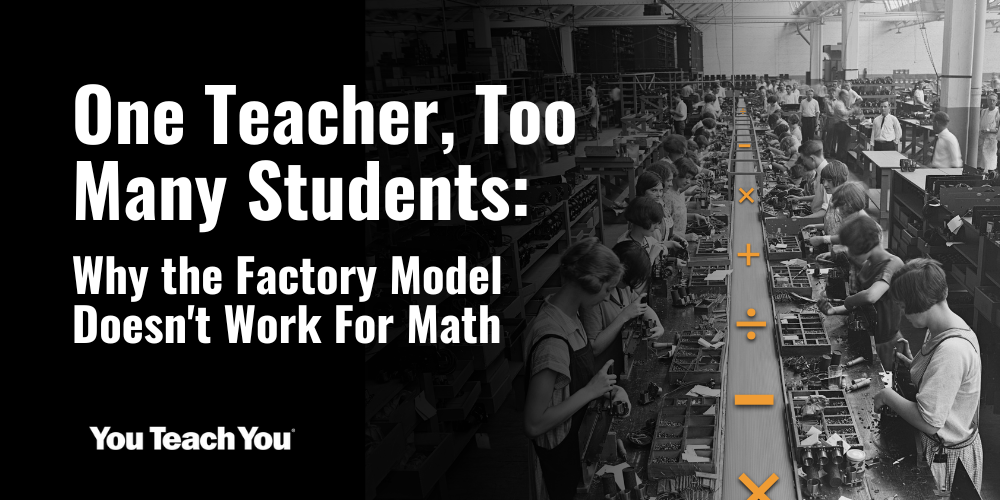It’s time to talk about the elephant in the classroom: the traditional model of math education where one teacher is responsible for way-too-many students. This system - though it’s rarely acknowledged - is an assembly line, and a malfunctioning one at that. Students are expected to progress through the curriculum at a uniform pace regardless of their backgrounds, individual needs, or levels of understanding. Is it any wonder, then, that so many of them don’t make it?
This "factory model" of math education has persisted in the United States for decades, and yet has consistently failed to deliver the results this nation needs; American students continue to lag far behind in international math rankings, while significant achievement gaps stubbornly persist within the country itself. It's time to face up to the inherent and inevitable flaws of the factory model and explore alternative approaches.
One-Size-Fits-Few
In a typical American classroom, the teacher is tasked with delivering instruction to a large and diverse group of students, each with their own individual and highly specific learning needs. This almost invariably leads to a “one-size-fits-few" approach that fails to meet the needs of every student. Such an approach can’t help but lead to:
- Pacing Problems: The teacher sets the pace, which can be too fast for some, leaving them confused and struggling, and too slow for others, leading to boredom, disengagement - and misbehavior.
- Limited Individualized Attention: It's practically impossible for an individual teacher to provide individualized support to every single student under the factory model, especially those teachers dealing with large class sizes period after period, day after day. This situation results in many students falling behind and not reaching their full potential (to put it very mildly).
- Missed Opportunities: Students who are absent or miss a key concept can easily get lost under this model. Catching them up becomes an additional burden for the teacher, often leading to further delays and learning gaps, as well as frustration for all involved.
Traditional and Progressive: Both Stuck in the Same Model
Progressive approaches are just as afflicted with the "one-teacher-to-many-students" problem as traditional instruction.
- Traditionalists, with their emphasis on direct instruction and structured learning, often rely on the teacher as the sole source of knowledge, leaving little room for individualized pacing or genuinely differentiated learning at the student level.
- Progressives, while advocating for inquiry-based learning and student-centered activities, often struggle to provide the necessary structure and guidance for all students to succeed, especially in large group settings with diverse student populations and distractions based on peer pressure.
- Both approaches contain essential elements, but neither address the underlying larger problem posed by the factory model.
The Sequential Nature of Math Amplifies the Problem
Math concepts build upon each other in a sequential and hierarchical manner; if a student doesn't master foundational concepts, they'll struggle with subsequent ones. The one-teacher-to-many-students model, regardless of whether the teacher takes a progressive or traditional approach, only exacerbates this issue:
- Accumulating Gaps: As students move through the curriculum, gaps in their understanding accumulate, creating a snowball effect that makes it increasingly difficult to keep up.
- False Sense of Progress: Under this model, students can easily get passed along to higher grade levels without mastering concepts and skills from the lower levels. This creates a false sense of progress, setting them up for failure later on - both in school and life outside of it.
- Math Anxiety and Avoidance: The frustration and confusion caused by these accumulating gaps can lead to math anxiety and lack of confidence, further hindering - and even preventing - student progress, and possibly triggering lifetime math avoidance.
The Need for a New Approach
The persistent underperformance of American students in math, despite decades of reform efforts from all points along the educational spectrum, suggests that the one-teacher-to-many-students model itself is the culprit. It's time to explore an alternative approach that prioritizes individualized learning, mastery, and student agency - all at the same time.
This approach must involve:
- Personalized Learning that Works in Large Group Settings: Contrary to what many assume, this need not require interactive technology - which can bring with it a host of its own problems, including online distractions, non-serious student interaction, and off-task play (in addition to substantial costs of the technology itself). Paper-based self-instructional sequences based on ample examples, related practice problems, and instantly accessible feedback can easily do the trick (and at a mere fraction of the cost too).
- A Mastery-Based Progression: Students must be allowed to progress at their own pace and demonstrate mastery of each concept and skill before moving on. This mastery of concepts and skills must be non-negotiable.
- A Way for All Students to Catch Themselves Up: Structured “see it, do it, check it” self-instructional sequences based on self-explanatory worked examples and fully-worked solutions permit students to go back and self-remediate, and to do so without calling any unwanted attention to themselves. (Everyone in this model is always just “learning math,” without reference to anyone else.)
- Individualized and Small-Group Support: Teachers must be freed up, via self-explanatory, self-instructional materials, to provide students with assistance, guidance, and inspiration at both the individual and small-group levels.
- Teacher as Mentor, not Master: Teachers must transition from being the sole source of instruction and content in their classrooms to being facilitators of meaningful and demonstrably effective student-centric learning, learning that ultimately takes account of students’ individual interests and creativity, and prepares them to take on and solve their own real-world problems.
It's time to move beyond the industrial-age factory model at last, and to embrace a genuinely personalized and mastery-based approach to math education. This will require the courage to challenge traditional assumptions, explore new possibilities, and prioritize student learning above all else. Only then can we hope to unlock the full potential of every single learner, and create an effective - and truly equitable - math education system for the future.

